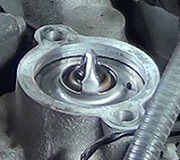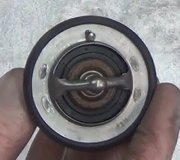First we need to know the exact diagnostic fault code number that was set when the Check Engine light turned on. No fault code ever says a part needs to be replaced or is defective on any car brand. Fault codes only indicate the system or circuit that needs further diagnosis, or the unacceptable operating condition. When a part is referenced in a fault code, it is actually the cause of that code about half of the time.
The most common problem caused by faulty thermostats is they stick open, then the engine fails to reach normal operating temperature. Chryslers actually do have a fault code for that. The code sets when the engine doesn't reach a specified temperature within six minutes of starting it. In cold climates, like in the upper half of the U.S, every Chrysler vehicle is going to have that code in the winter, but that is one of the half of the codes that do not turn on the Check Engine light. Of the over 2,000 potential fault codes that can be set, only those related to something that could adversely affect emissions will turn the Check Engine light on.
As for the cooling system flush, I suspect the service advisor is looking out for your wallet in the long term. There is going to be a lot of sand inside the cooling system that failed to get knocked out when the engine block was cast. Most of that sand sticks in one area and doesn't cause a problem, but over time, it's somewhat common for some to get swept into the heater core and plug it. That results in cold air being blown from the vents. The fix for that is relatively easy, but time-consuming to remove the hoses, then flush the heater core.
If the thermostat really does need to be replaced, part of what needs to do a cooling system flush is already done, so it's silly to not do the whole job, then come back and do it all over again a year or two later. This is where doing the complete service now is less expensive than doing part of it now and all of it later.
Also, I know some brands of antifreeze can go longer now, but in the past, the standard of service was to replace it every two years. Antifreeze is alcohol, which is always going to be alcohol, but it's the additives that wear out in about two years. Due to combustion system gases naturally sneaking into the cooling system, acids are formed that will attack the metal parts. You'll find brass, iron, aluminum, and tin in cooling system parts. Any time you have two different metals and an acid, you have a battery and the chemical reaction that goes with that. That results in "galvanic action" which is a fancy name for corrosion. Antifreeze contains water pump lubricant, anti-foaming agents, seal conditioners, and corrosion inhibitors. Those are the additives that wear out in about two years.
When I worked for a very nice family-owned Chrysler dealership, we always recommended changing the coolant every two years, but the first time that was often just a "drain-and-fill". That means no flush of the entire system. By pulling the lower radiator hose loose, about 3/4 of the coolant drained out, then we simply refilled the system. That got enough new additives in the system to protect it. At the second service is when we recommended the complete flush because by that time most of that casting sand stuck in the block was ready to be knocked loose so it could be removed. After that we only did drain-and-fills unless the coolant had become contaminated.
The normal cooling system flush doesn't involve removing the thermostat, but removing the thermostat does involve having to refill the system and adjust the mixture for the correct freeze point. Refilling and adjusting the mixture is part of the flush that is recommended at 150,000 miles. It sounds to me like your service advisor wants to add the flush now, when part of the job is already being done, rather than making you pay for the entire procedure a year or two from now.
As a side note, this is a real big problem for owners of GM vehicles. GM advertised their vehicles as having "life-time" antifreeze to make their cost of regular maintenance appear lower than that of their competitors. But under the hood the sticker says to replace the coolant every three years. Even the Dex-Cool company that supplied the antifreeze doesn't agree with that. They say to replace it every two years, just like every other brand. Now people are getting caught with leaking radiators and heater cores due to corrosion. Replacing a heater core can easily be an entire day-long job on many models, so it's an expensive repair caused by saving a few dollars on coolant. Given the age of your vehicle, if the cooling system has never been serviced yet, I'd be much more nervous about a leaking radiator or heater core than the cost of the flush.
I'm not happy with the cost you were quoted for the flush, but a lot of vehicles today call for special antifreeze formulations that are compatible with the new metal alloys in the engines. Most of those special antifreezes cost a lot more than what we're used to paying. The flush can take an hour or more with all the hoses to disconnect and the mess to clean up, so the estimate for the service does sound reasonable. The good news is all dealers keep records of the services they perform, so you shouldn't have the flush recommended again later.
Consider asking what the cooling system flush would cost at 150,000 miles if no other service or repairs are needed at that time. If you're told $120.00, they aren't saving you anything by doing it now, so it might make sense to wait. Replacing the thermostat is listed as taking 0.9 hours. There is no time listed for the flush, but as I mentioned, part of that flush service is already being done with the thermostat job. When two or more related procedures are listed in the "flat-rate" guide, they always list a combined-time that is less than the total for the two jobs separately. I suspect you're going to find the flush by itself a couple of years from now will cost more than $120.00. By doing the flush now, part of that cost is being absorbed into the thermostat job.
Monday, October 14th, 2019 AT 4:47 PM



